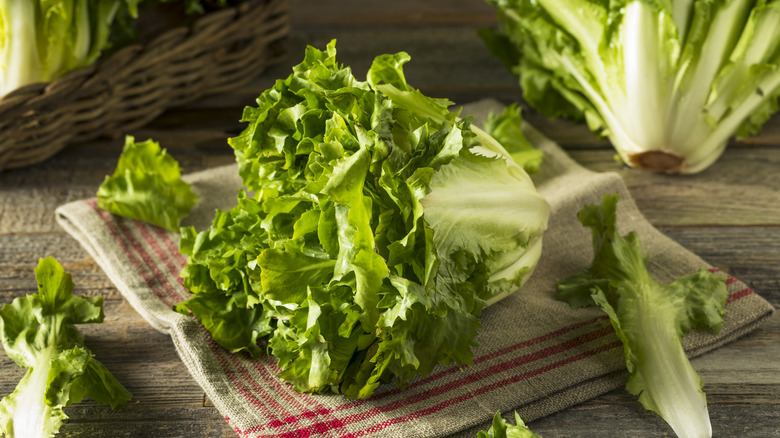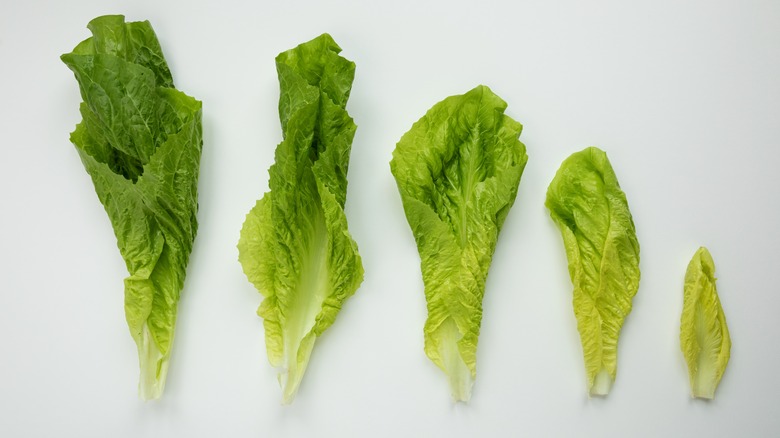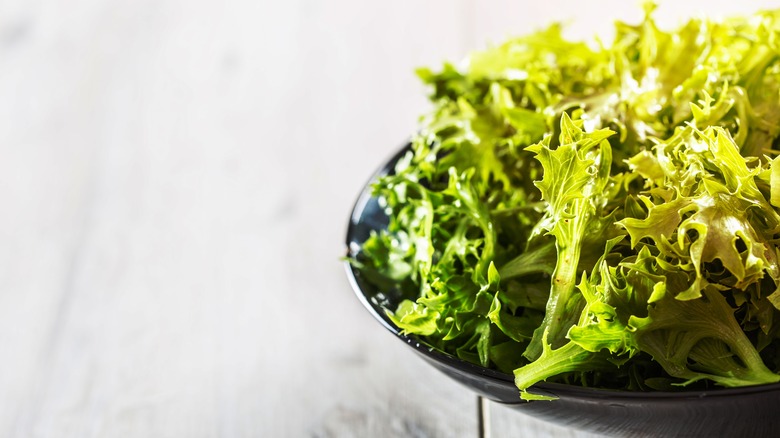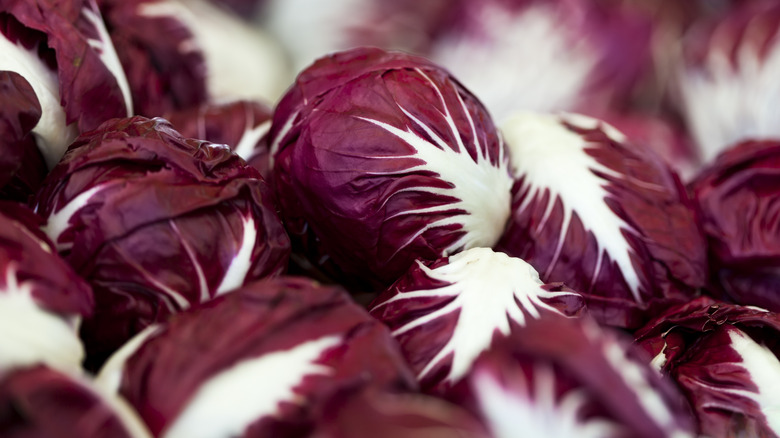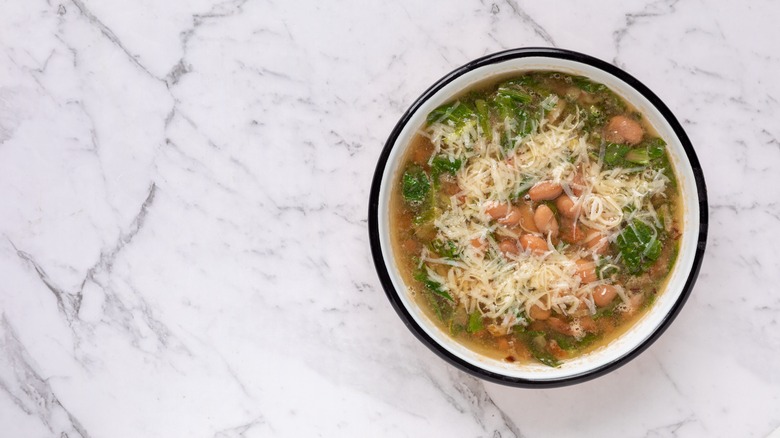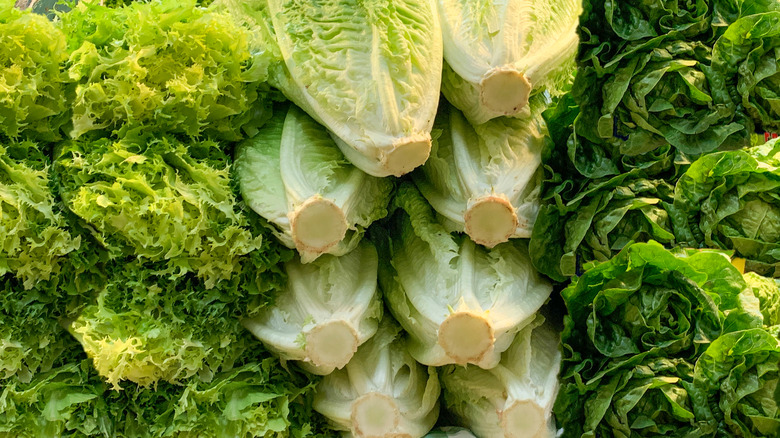What Exactly Is Escarole?
If you've ever enjoyed a bowl of authentic Italian wedding soup, you should be familiar with escarole's unique taste and texture. This leafy green looks very similar to butterhead lettuce, except the edges of its leaves are jagged and crinkly. Its slightly bitter flavor and semi-firm texture make it highly versatile and an excellent addition to many raw and cooked dishes. Though widely grown in North America and Europe, escarole is most closely associated with Italian (particularly Sicilian) cuisine. It has yet to achieve such popularity in the United States, but if you give it a chance and handle it properly, you'll unlock a host of new flavors and textures in your cooking.
Escarole is a bit enigmatic, possibly having the vaguest name in the history of food. It comes from the Medieval Latin escariola, meaning "something edible." It is one of two varieties of Cichorium endivia, a member of the chicory family. Escarole (also known as Batavian or broad-leaved endive) is scientifically known as Cichorium endivia var. latifolium, while its close relative frisée (also known as curly endive) is scientifically known as Cichorium endivia var. crispum. We'll dig more into the differences between these two in a moment, but first, let's talk about what escarole can bring to your cooking.
What does escarole taste like?
Escarole is slightly bitter but not overwhelmingly so. If you are a bit cautious about bitter greens, this would be the perfect option to start experimenting with. The level of bitterness also changes depending on which part of the plant you eat. Each head of escarole has dark green outer leaves and pale, slightly yellow inner leaves, with the inner leaves being milder than the outer ones. You can further mellow out the bitterness of escarole by cooking it.
Texture is the other key component of escarole. Firmer than lettuce and spinach but more tender than kale and chard, it represents the Goldilocks zone of leafy greens. Whereas kale and chard can often be too tough to comfortably eat raw (unless you're looking for a real jaw workout) and lettuce and spinach tend to wilt into mush when exposed to heat, endive presents neither of these issues. It is a delightful, slightly toothsome addition to salads and can retain a slight crunch when added to soups and sautées.
Nutritional value of escarole
Escarole, like other bitter greens, is generally considered an extremely healthy addition to your diet, supplying many nutrients while possessing relatively few calories. According to Healthline, a two-cup serving of raw escarole contains 15 calories, three grams of carbohydrates, one gram of protein, zero grams of fat, and three grams of fiber. That last note may not sound like much, but three grams of fiber is 12% of the recommended daily value. Most Americans do not get enough fiber in their diet, which is essential because it helps regulate both digestion and blood sugar levels, so any ingredient that packs a lot of fiber into a small serving such as escarole can be a valuable addition to your meals.
Escarole is even more notable for its rich concentration of vitamins, particularly vitamins A and K. Vitamin A supports your vision and immune system, and two cups of escarole can provide 54% of the recommended daily value. Vitamin K is essential for blood clotting, and two cups of escarole provides a stunning 164% of the recommended daily value. However, it is important to note some concerns in the medical community about vitamin K inhibiting the effects of blood thinners, particularly Warfarin (Coumadin). If you take this medication, escarole and other foods high in vitamin K aren't necessarily off-limits, and consistent amounts are actually important to have, but you should ask a doctor about the limits of your diet.
Escarole vs. other chicories
The chicory family includes escarole, frisée, radicchio, and Belgian endive, each with a unique taste and texture. Escarole is generally the least bitter of the bunch and tends to have a more tender texture. Of all the other chicories, the one most closely related to escarole is frisée. They are both varieties of the same species (Cichorium endivia) but differ in appearance and texture. While escarole has broad leaves similar to lettuce, frisée has very narrow leaves with curly tips. Frisée is slightly more bitter than escarole but not nearly as much as other chicories, and like escarole, its inner leaves are much milder.
The other two main varieties of chicory are radicchio and Belgian endive, which belong to a different species: Cichorium intybus. They are considerably more bitter than either escarole or frisée, and their leaves are firmer. Radicchio looks like a purple cabbage and is the crunchiest of the chicories, while Belgian endive has tall, thin leaves with thick ribs running down their centers.
There can be some confusion with the names of these different vegetables. Both escarole and frisée are considered to be varieties of endive, with escarole sometimes going by the name "broad-leaved endive" and frisée often referred to as "curly endive." However, when you see the word "endive" on a menu, it probably refers to Belgian endive.
How to cook with escarole
Escarole can be cooked or eaten raw. Raw escarole is mainly used in salads and is often included in mesclun — a blend of salad greens that typically includes arugula, chervil, and sometimes even spinach or kale. Even though escarole isn't as bitter as other chicories, it can still overwhelm a salad if the other ingredients are too mild. It's best to pair escarole with intense flavors such as aged cheese and acidic vinaigrette. Because its leaves are sturdier than lettuce, escarole holds heavier, creamy dressings well, and you can use it as a bed for freshly-grilled meats without it wilting.
You can mellow out the bitterness of escarole by cooking it. For a simple side dish, try sautéeing escarole in olive oil and garlic. Some shallots or chili flakes would make a great addition here, and if you wanted to take it to the next level, you could add bits of bacon or pancetta. Salty meats pair beautifully with bitter escarole. As mentioned before, escarole is big in Italian cuisine, and it's a classic addition to pasta and cannellini beans. However, escarole's most iconic use is in soups. The most famous is Italian wedding soup, but it's also a popular choice of leafy green for stracciatella — Italian egg drop soup. If you enjoy any soup or sauce that uses spinach, try substituting escarole next time. It won't wilt as much under the heat, and that gentle crunch can really elevate a dish.
Where to find escarole
The leafy chicories (escarole and frisée) are perennials. You can find them in stores year-round, peaking in the spring and summer. Even though it's not the most popular leafy green in America by any means, it's still widely available in the states, with California, Arizona, and Florida all being prominent producers of escarole. The latter has even given its name to a particular variety of escarole — Florida Deep Heart — the hearts of which are so tender that they almost have a creamy texture.
Searching for escarole in the grocery store is a bit counterintuitive. You would expect it to be grouped in the produce section with its nearest relatives, radicchio and Belgian endive, but this is not the case. Escarole is typically shelved alongside lettuce and kale, which can cause some problems if you don't pay close enough attention to the signage. If someone were looking for a sweet head of lettuce and grabbed hold of some escarole, they'd get quite a surprise when it came time for their salad course.
